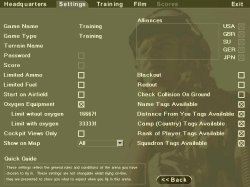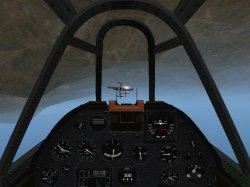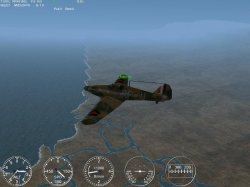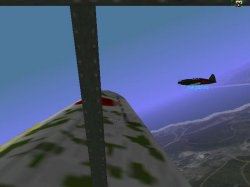|
Fighter Ace II Beta Preview
by Biff Henderson |
||||
|
For online play, all of the above settings are configured on the server, by arena. Though not available at the time of this writing, private arenas will made available, where the player hosting can set all of these options, plus put a password on his arena. The host will also be able to set what aircraft are available and any country alliances. These private arenas promise to be excellent environments for squad vs. squad challenges, among other things.
 Arena Settings The Zone now supports squadrons. The CO will establish the squad, and pilots petition for membership. A single pilot may be a member of more than one squad. When flying FAII on the Zone, the player will select which squad he is flying for (or none). Scores are kept for individual pilots as well as squadrons. The scoring scheme is still is still undergoing modifications, but it basically works like this: You score points for shooting down aircraft and destroying ground targets. The number of points depends on the aircraft involved. Scoring a kill while flying a Hurricane is worth more points than if you were flying a Spit XIV. Shooting down a B-17 is worth more points than a P-40. The relative ranks of the pilots involved also matters. A general that shoots down a cadet won't score many points, but that cadet shooting down a general will! You lose points for getting shot down. The same aircraft and rank considerations apply. You'll lose more points for getting killed rather than bailing out. You'll also lose more points if you come down in enemy territory. Taking it up for a spin As FAII is still in beta, the flight models are undergoing adjustments based on the players' feedback. Currently, the model has an EAW feel to it. There are basically three different difficulty levels presented: arcade, intermediate, and realistic. These range from very simple to fly, to quite difficult, and there are separate arenas for each. The arcade model is just that - planes never depart controlled flight, and there are no torque effects or adverse yaw. If you point your aircraft straight up, it will eventually run out of airspeed and just flop over; however, slips and skids are possible. The realistic model has all of the difficulty options enabled: accelerated stalls, spins, and the need to make trim adjustments among other things. The realistic arenas also limit players to cockpit views only - meaning no full screen or external views are available. One neat feature, however, is that the players are allowed full screen and external views while taxiing around the airfield and taking off. This is very useful for keeping your plane on the runway, and avoiding collisions with other planes and buildings on the field. The intermediate arena is a middle ground between arcade and realistic physics. Fighter Ace II is attractive, in that it offers an 'upgrade path' for novice flight simmers. Rather than having to dive headfirst into complex and difficult flight models, the player can start out in the arcade arenas. As the player's experience and skill grows, he can move up through the intermediate and eventually into the advanced physics arenas. Before jumping into your favorite aircraft and hitting the unfriendly skies, you are given the option of selecting your ordnance loadout (if applicable). Most of the aircraft are capable of carrying bombs and/or rockets. All of the rockets have a timed fusing, meaning if they don't hit anything after a certain time they will explode in mid-air. This isn't very realistic (except for certain German and Russian models) but they are great fun for air to air work (and for nipping those extending Runstangs in the butt). You can also set machine gun and cannon convergence, although you don't have the ability to set convergence for pairs of guns - i.e. all 6 guns of the P-51D will converge at the same distance. You can also choose how much gas to take on if the arena has fuel limits. This can be very important when you're trying to get that fully loaded B-17 airborne from a 5000ft ASL field! |
 In flight, the player has a number of views available. There are the standard 8-way views, with 'up' modifiers, and a straight up view. These can be either fullscreen or cockpit obscured (which can be restricted via arena settings, as mentioned above). There is also a fully pannable virtual-cockpit view mode. This can be panned with the mouse and/or keyboard. In addition to these 'from the pilot's seat' views, there are a few external views available (also arena restricted). There are no 'enemy' views available - that would be too unfair in that they would allow you to see what the bad guys were flying and what bombs/rockets they might have strapped on.
 While in the fullscreen view, a textual readout of altitude, airspeed, throttle, gear and flap settings can be displayed at the top of the screen. The player can also configure any or all of six instrument gauges to appear at the bottom of the screen. These are: altimeter, ASI, VSI, dive/bank indicator, and compass. Personally, I fly with only the VSI and dive/bank indicator displayed, as you can see by most of my screenshots.
 And then there's the padlock view mode. To padlock, you must first use the conventional views to look in the direction of your target, then hit the padlock key. There is a key to let you choose the nearest target, and keys to cycle through the targets in that direction. There are separate padlock keys for friendly and enemy, and your selected target is 'saved' so that you may switch back and forth from padlock to other views without losing lock on your target. Padlock Implementation Fighter Ace II has the best padlock implementation of any flight sim - online or off - that I've ever flown. Rather than the targeted aircraft being centered in the view, it's offset slightly to the side that you would need to 'pull' to bring your nose on them. If you are wings level and have a bogie to the left of you padlocked, he will appear to the left of center in padlock view. If you then roll 90 left, his position in padlock will slide around to high of center. Getting 'lost in padlock' isn't as much of a problem in FAII as it is in other sims. To help you find someone to kill, there is a map display which shows the positions of every aircraft within a certain radius of you. The map symbols are color coded so you will know which country's aircraft are where, though not which types they are. Ground installations and the background grid of the map are also color coded to show which country owns what territory. FAII does not have built-in voice comms, but with most players these days using Battlecomm or Roger Wilco, this isn't really an issue. It does have a pretty sophisticated radio however. The radio sports thirteen channels, which the player can independently set to receive-only, transmit/receive, or off. There are channels for 'global team-only', 'global enemy-only', and 'squadron'. The remaining ten channels are team-only. The radio range is linked to the map range, so if a plane is outside your 'map sphere', it's also outside your radio range. Go to Part III: Damage Modeling
|
|||
|
Copyright © 1997 - 2000 COMBATSIM.COM, INC. All Rights Reserved. Last Updated October 13th, 1999 |
||||
